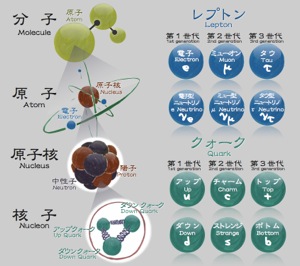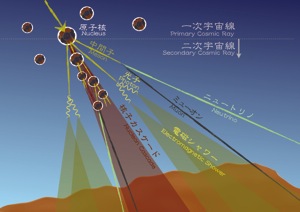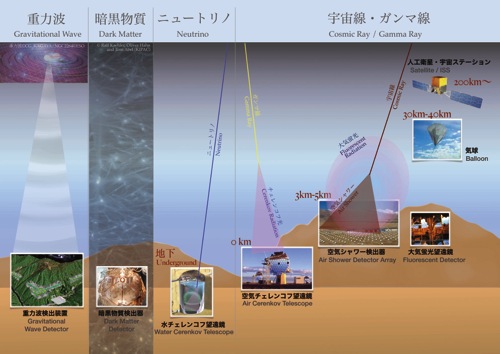| From the Director |
| History |
| Chronology |
| Cosmic Ray |
| Reserch Groups |
| ICRR News |
| Organization |
| #of Staff & Directors |
| Faculties |
| Publications |
| Job Opportunities |
| Administration Div. |
| Library |
 |
 |
About ICRR
What are Cosmic Rays?
|
High-Energy Particles from Space  These particles are mostly the nuclei of the same atoms that constitute our everyday matter. About 90 percent of the cosmic rays are hydrogen nuclei\namely protons, 9 percent are helium nuclei, and the rest are heavier nuclei and elementary particles such as electrons and positrons. It was not until the early twentieth century that scientists realized high-energy radiation originates not just from radioactive nuclei on earth, but also from outer space. In 1912, an Austrian physicist Victor Hess ascended in a balloon up to the altitude of 5 kilometers, and found that his electroscope discharged more rapidly as he ascended, which he attributed to radiation entering the atmosphere from above. This marked the discovery of cosmic rays. Cosmic Ray Air Shower
 When a primary cosmic ray from space collides with an air molecule, it breaks apart the nucleus of the molecule, resulting in production of multiple high-energy particles (called ghadronsh), which then fly apart at nearly the speed of light, further striking the surrounding air molecules, producing more particles. The chain reaction quickly grows and the product particles soon decay into many types of lighter particles such as muons, neutrinos, gamma-rays, electrons, and positrons. This cascade of particles is called an gair shower.h A typical air shower develops into hundreds of billions of secondary particles, raining on an area covering several hundred square meters on the ground. Muons, mesons, and positrons were first detected in air showers, bringing about profound impacts on the field of elementary particles. However, the field of Cosmic Ray Astronomy is yet to see major breakthroughs: there are still so many questions to explore, the most significant of which being, for example, what are the sources of high energy cosmic rays, and how they propagate through space before arriving the Earth. Sources of Cosmic Rays
Primary cosmic rays impact on the Earthfs atmosphere with a very wide energy spectrum, from 108 to 1020 electron volts. The number of primary cosmic rays decreases exponentially with energy. A cosmic ray particle of the highest energy has energy that is equivalent to the energy a lightning bolt emits every second\a hundred trillion times the energy of a typical particle emitted by a radioactive nucleus, and ten million times the energy of the highest energy man-made particle accelerator can produce. This indicates that the universe must contain somewhere the mechanisms that can accelerate particles to such enormous energies. Recent studies have found that supernova are one such sources of cosmic rays, but they cannot explain every cosmic ray. Ultimately, cosmic ray scientists aim to uncover the mysteries of the evolution of the universe by understanding the mechanisms of very high-energy astrophysical events occurring at enormous distances from the Earth. Cosmic rays are, to scientists, gmessengersh sent to mankind that convey messages from the edge of the universe, with a great potential to bring answers to questions that are asked in a wide range of fields in physics and astronomy. Gamma-rays, neutrinos, and gravitational waves

Such messengers bring information unavailable in ordinary cosmic rays. They are abundantly produced in high-energy astrophysical events, and travel straight through space without being affected by galactic magnetic fields to convey information of the environment they were produced. Recent technological developments have overcome many observational difficulties, and brought forth a new era of gamma-ray and neutrino astronomy. Today, with the new kilometer-scale gravitational wave telescope currently under construction in Kamioka mine, scientists will acquire new geyesh with which to see the universe. Gravitational waves are ripples in the space-time which propagate through space at the speed of light. Detection of gravitational waves will uncover large portion of the universe that are, with the traditional probes, unobservable; such as, mergers of black-holes and the birth of the universe. With the addition of neutrino, gamma-ray, gravitational wave, and dark matter experiments to probe a broad range of cosmic events, Institute for Cosmic Ray Research at the University of Tokyo continues to be the only research center in the world that hosts a comprehensive array of leading cosmic ray research programs.
Methods of Cosmic Ray Detection
Many cosmic ray experiments utilize arrays of telescopes and/or particle detectors that cover a large area of ground to detect air showers. Scientists use the data from air showers to reconstruct the primary cosmic ray events and to analyze their energy and chemical composition. There are multiple types of ground-based cosmic ray telescopes currently in use. The first is called an extensive air-shower array, which measures ionizing events of charged particles passing through the detectors. Air-shower array experiments are sensitive to high-energy cosmic rays and can observe a broad area of the sky at any time. The second type of ground-based cosmic ray detector is an air Cerenkov telescope. It detects Cerenkov radiation emitted when charged particles in an air shower travel faster than the speed of light in air (light travels slower in a medium than in vacuum). An air Cerenkov telescope is only used during the moon-less nights, but is sensitive to lower-energy cosmic rays. The third detection method, a Water Cerenkov telescope, detects Cerenkov radiation produced in water instead of air, is also employed in ground-based air shower arrays and underground neutrino experiments. Another method is to detect the fluorescent glow in atmosphere due to excited nitrogen molecules along the paths of electrons and positrons in the air shower. The method gives high directional resolution, and is therefore often combined with Cerenkov telescopes and air shower arrays. Balloon experiments and satellite cosmic ray detection methods give complementary data to ground-based cosmic ray observation. By detecting primary cosmic rays from space directly, these high-altitude experiments have made many important contributions in probing the acceleration and propagation mechanism of cosmic rays. With new objectives to investigate dark matter and antimatter, they continue to be essential to our cosmic ray research. |